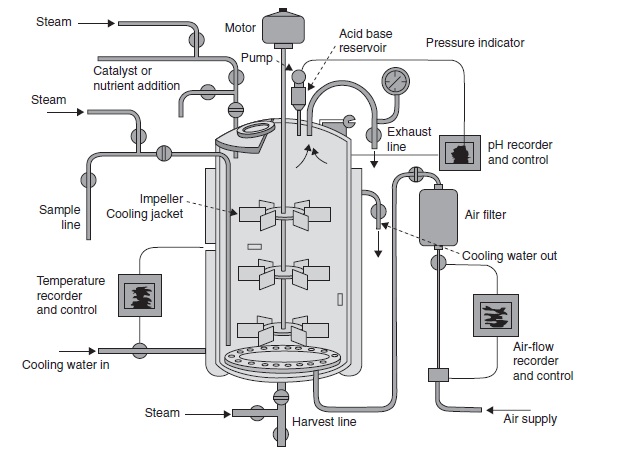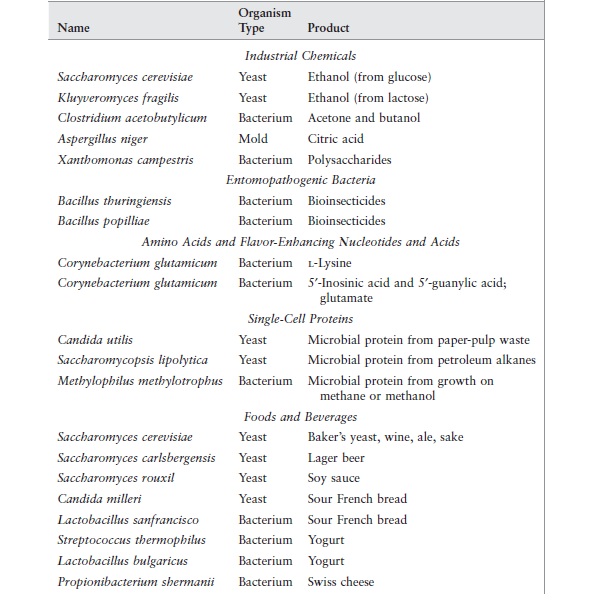MICROBIAL FERMENTATION
Fermentation is the enzymatic decomposition and utilization of food stuffs, particularly Carbohydrates, by microbes.
BIOCHEMISTRY
Fermentation is the process of extracting energy from the oxidation of organic compounds, such as Carbohydrates, using an endogenous electrone acceptor, which is usually an organic compound.
TYPES
1. Batch fermentation
2. Continuous fermentation
Some people seem to be saying aerobic and anaerobic which is equally correct, that is done in the presence of oxygen and in the absence of oxygen respectively.
BATCH FERMENTATION
Batch fermentation is well, done in batches where are process continues until the necessary nutrition inside the batch is depleted by the microorganisms doing the fermentation and eventually in the case of alcohol the produces of fermentation which is ethanol poisons the bacteria, hence stopping the process or the nutrition is depleted.
CONTINUOUS FERMENTATION
Continuous fermentation is well, continuous in the sense that theoritically it could keep going. through, few industrials processes with the exeption of perhaps mycoproteins continue indenitely. The products of fermentation are continuously filtered off and the nutrients in the mix replenished at a constant rate so the overall concentration of nutrients remains the same and fermentation progresses indefinitely.
SCHEMATIC PRESENTATION OF A FERMENTER
MICROBIAL CULTURE COMPOSITION AND CLASSIFICATION
Microbial cells are either prokaryotes or eukaryotes, microbial organisms are important organisms with a long history of human uses for everything ranging from the production of bread, beer, wine and cheese to more recent uses for generating bio fuels, bio polymers and pharmaceuticals.
1. Cell membrane consisting of lipids
2. DNA that stores code for all the proteins in the cell
3. Transfer of the DNA's information via RNA
4. Proteins synthesis carried out via structure called ribosomes
YEAST FERMENTATION
Yeast are singal celled microorganisms that reproduces by budding. They are biologically classified as fungi and are responsible for conventing fermentable sugars into alcohol and other byproducts. They are literally hundreds of varieties and strains of yeast. In the past, there were two types of beer yeast; ale yeast(the top fermenting type, Saccharomyces cereviceae) and lager yeast (the bottom fermenting types, Saccharomyces uvarum formerly known as Saccharomyces carlsbergensis)
TOP FERMENTING YEAST
Ale yeast strains are best used at temperatures ranging from 10 to 25 degree C, through some strains will not actively ferment below 12 degree C. They are generally regulated as top fermenting yeast since they rise to the surfce during fermentation, creation every thick, rich yeast head. That is why the term "top fermenting" is associated with ale yeasts. fermentation by ale yeasts at these relatively warmer temperatures produces a beer high in esters, which may regard as a distinctive character of ale beers.
BOTTOM FERMENTING YEAST
Lager yeast strains are best used at temperature range from 7 to 15 degree C. At these temperatures, lager yeasts grow less rapidly than ale yeasts, and with less surface foam they tend to settle out to the bottom at the fermenter as fermentation nears completion. This is why they are often referred to as bottom yeasts. The final flavous of the beer will depend a great deal on the strains of lager yeasts and the temperature at which it was fermented.
SPONTANEOUS FERMENTATION
Beer that is exposed to the surrounding open air to allow naturally/wild yeast bacteria to literally infact the beer are spontaneous fermented beers one at the typical yeasts is the Brettanomyces lambicus strain.
FERMENTATION TECHNIQUE
SIMPLE FERMENTED BEVERAGES
This is meant to be a simple guide to basic fermentation produces. and is not meant to be a comprehensive manual. Most is based on personal experience making meads, when and ciders. The intent is to use as little special equipments or ingredients as possible, using whenever possible those things easily obtainable at a grocery store or hardware store. some recommendations are made for things that may be bought at a beer or wine making supply store, but all at these suggestions are optional.
FERMENTATION PROCESS IN BREWING
Fermentation in brewing is the conversion of Carbohydrates to alcohol and carbon dioxide or organic acids using yeast, bacteria or a combination thereof, under anaerobic conditions. A more restricted definition of fermentation is the chemical conversion of sugars into ethanol. The science of fermentation is known as zymurgy.
After the wort is cooled and aerated-usually with sterile air-yeast is added to it, and it begins to ferment. It is during this stage that sugars won from the malt ate metabolised into alcohol and carbon dioxide, and the product can be called beer for the first time. Fermentation happpens in tanks which come in all sorts of forms, from enourmous cylindro-conical vellels, through open stone vellels, to wooden vats.
Most breweries today use cylindro-conical vessels, or CCVs, which have a conical bottom and a cylindrical top. The con's apeture is typically around 60 degree C, an angle that will allow the to flow towards the cone's apex, but is not so steep as to rake up too much vertical space CCVs can handle both fermenting and condioning in the same tank. At the end of fermentation the yeast and other solids which gave fallen to the cone's apex can be simply flushed out of a port at the apex.
Open fermentation vessels gave no tops, which makes harvesting top-fermenting yeasts very easy. The open tops of the vessels make the risk of infection greater, but with proper cleaning procedures ask careful protocol about who enters fermentation chambers, the risk can be well controlled.
Frementation tanks ate typically made of stainless steel. If they are simple cylindrical tanks with beveled ends, they are arranged vertically, as opposed to conditioing tanks which are usually laid out horizontally. only a very few breweries still use wooden vats for fermentation as wood is difficult to keep clean and infections-free and must be repitched more or less yearly.
After high krausen occurs, a bung device is often put on the tanks to allow the CO2 produces by the yeast to naturally carbonate the beer. This bung device can be set to a given pressure to match the type to beer being produced. The more pressure the bung holds back, the more carbonated the beer becomes.

